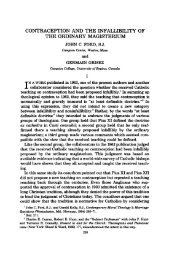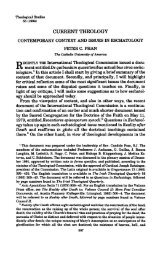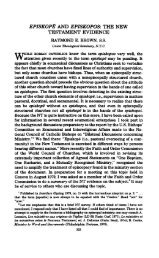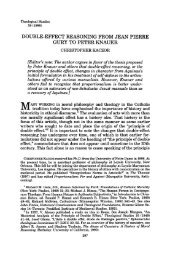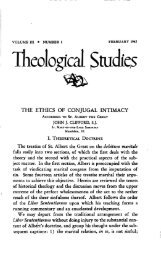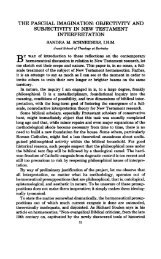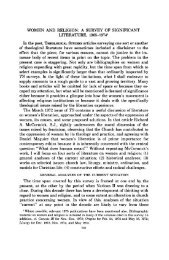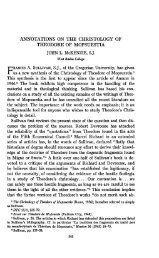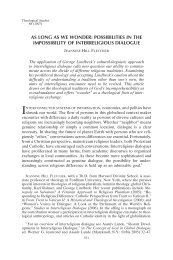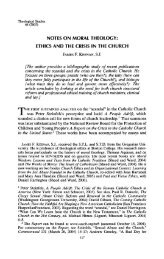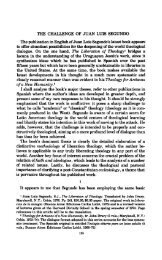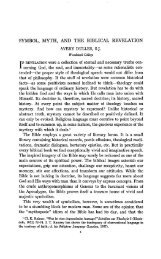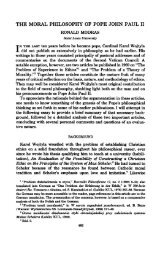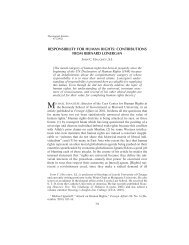THE ODYSSEY OF A FAMILIAR PRAYER DPMINE Iesu Christe, Fili ...
THE ODYSSEY OF A FAMILIAR PRAYER DPMINE Iesu Christe, Fili ...
THE ODYSSEY OF A FAMILIAR PRAYER DPMINE Iesu Christe, Fili ...
You also want an ePaper? Increase the reach of your titles
YUMPU automatically turns print PDFs into web optimized ePapers that Google loves.
<strong>THE</strong> <strong>ODYSSEY</strong> <strong>OF</strong> A <strong>FAMILIAR</strong> <strong>PRAYER</strong><br />
D PMINE<br />
GERALD ELLARD, S.J., Ph.D.<br />
ST. MARY'S COLLEGE<br />
St. Mary's, Kansas<br />
<strong>Iesu</strong> <strong>Christe</strong>, <strong>Fili</strong> Dei vivi, qui ex voluntate<br />
Patris, cooperante Spiritu Sancto, per<br />
mortem tuam mundum vivificasti: libera me per hoc<br />
sacrosanctum corpus et sanguinem tuum ab omnibus<br />
iniquitatibus meis, et universis malis: et fac me tuis<br />
semper inhaerere mandatis, et a te numquam separari<br />
permittas: qui cum eodem Deo Patre, et Spiritu<br />
Sancto vivis et regnas Deus in saecula saeculorum.<br />
Amen.<br />
A S often as he celebrates the Eucharistic Sacrifice, and at<br />
a most solemn moment just before communicating,<br />
every priest of the Roman Rite says the prayer just quoted. It<br />
has been an obligatory part of the Roman Mass since the missal<br />
ordered by the Council of Trent was published in 1570. For<br />
some centuries prior to that date it was a common-place, if not<br />
obligatory formula in our Mass-rite. Within our living memory<br />
a large part of the laity has adopted the use of the Missal,<br />
and so it may be said that this prayer is rapidly winning a<br />
central position in the Eucharistic piety of millions. Since it is<br />
not an original, or even an early, part of the Roman Mass, it becomes<br />
doubly interesting to ask ourselves what is known about<br />
it. We would greatly like to know who wrote it. In what<br />
context is it first met with? Under what circumstances did<br />
it win acceptance in 6ur Missals, when no lack of other prayers<br />
for Communion have had their day and have perished? The<br />
present paper addresses itself in tentative and modest fashion<br />
to these questions. This survey must be regarded as tentative,<br />
because many of the extant sources are not now within my<br />
reach: no pretension can attach to this paper, if only for the
222 <strong>THE</strong>OLOGICAL STUDIES<br />
reason that the data for it have been supplied by others. But<br />
such at it is, it ought not be without value, since this prayer<br />
promises to go on molding the Eucharistic piety of ages yet unborn,<br />
as, in their turn, they shall show forth the death of the<br />
Lord until He come.<br />
Most books dealing with the text of the Mass, standard works<br />
like Gihr, 1 de Puniet, 2 Brinktrine, 3 and others, content themselves<br />
with stating that this prayer is first found in the eleventh<br />
century, and that by the fourteenth it had found its way in the<br />
Missals in use in Rome. From that place and date its diffusion is<br />
attributed to the Franciscan Friars, who had adopted the Massbook<br />
of the Roman Curia. Cardinal Schuster's The Sacramentary,<br />
says of this prayer, and its two accompanying ones in<br />
our present Missal, that they appear "in the codex of Ratoldus<br />
of Corbie," which is MS BN lat 12052, a tenth century source. 4<br />
The revised edition of Eisenhofer's Handbuch der Katholischen<br />
Liturgik gives a ninth century date and source for the prayer. 5<br />
Therein he is following the lead given by Victor Leroquais,<br />
whose monumental Les Sacramentaires et les Missels Manuscrits<br />
des Bibliotheques Publiques de France in 1924 had signalized<br />
this prayer as part of the first fully developed Ordo Missae and<br />
found in an Amiens manuscript of the second half of the ninth<br />
century. 6 From his minute, page-by-page investigations of<br />
the hundreds of manuscript Missals in France, and his command<br />
of the published literature, Leroquais doubtless had a closer<br />
acquaintance with such books than any one before him has<br />
achieved. At that the unique character of the Amiens Ordo<br />
Missae so impressed him that it drew from his pen a second and<br />
fuller account, "UOrdo Missae du Sacramentaire d'Amiens." 7<br />
Without wishing at that time, 1927, to enter into the history<br />
1<br />
N. Gihr, The Holy Sacrifice of the Mass (St. Louis: Herder, 1927), 725.<br />
2<br />
J. de Puniet, The Mass, Its Origin and History (London: BO&W, 1939), 181.<br />
3<br />
J. Brinktrine, Die Heilige Messe in Ihrem Werden u. Wesen (Paderborn: Schoningh,<br />
1931), 228.<br />
4<br />
I. Schuster, The Sacramentary (New York: Benziger, 1924) I, 308.<br />
5<br />
L.Eisenhofer, op. cit. (Freiburg i B: Herder, 1933), II, 211.<br />
^Leroquais, op. cit. (Paris, 1924) I, 30: work cited below as Leroquais.<br />
7<br />
Cf. Ephemerides Liturgicae, XLI (nov ser I), 1927, 43 5-45.
<strong>THE</strong> <strong>ODYSSEY</strong> <strong>OF</strong> A <strong>FAMILIAR</strong> <strong>PRAYER</strong> 223<br />
of any single prayer in the Ordo, Leroquais does make the<br />
statement:<br />
Une premiere remarque, c'est que, a part le priere Quod ore sumpsimus<br />
qui Ton trouve deja dans les sacramentaires de Gellone et d'Angouleme,<br />
dans le sacramentaire aujourd'hui perdu de Saint-Remi de Reims et dans<br />
celui de la bibliotheque de Saint-Gall, a part le Suscipe Sancta Trinitas,<br />
que Ton rencontre dans le sacramentaire de Rotrade, presque toutes les<br />
autres apparaissant ici pour la premiere fois, comme aussi apparait,<br />
realize pour la premiere fois le principe qui aura son plein epanouissement<br />
dans VOrdo Missae du missel romain. . . 8<br />
I. RECORDED BY ALCUIN<br />
Yet fifty to seventy-five years prior to this Amiens codex<br />
this formula was being used as we use it today before receiving<br />
Communion. I have before me a short memorandum I made on<br />
this prayer just ten years ago, wherein, after tabulating a few<br />
eleventh and tenth century manuscripts, as well as the Amiens'<br />
book just mentioned, there is the note, specially under-scored<br />
by reason of its early date: "In Alcuin's De Vsalmorum Usu:<br />
cf PL CI, 508." I had not, I am sure, read Alcuin's work at<br />
that time: my note was based on some source I had failed to<br />
record. Some years later I did 'discover* the prayer in Alcuin,<br />
and then 'discover' that I had made this memorandum on its<br />
occurence long before. How we learn by ceaselessly forgetting!<br />
It was then I resolved to pursue some day the traces of this<br />
prayer in its wanderings. Since then I recall one printed reference<br />
to the Alcuinian connection. When Adrian Fortescue's<br />
scholarly work on the history of the Mass was first published<br />
in 1912, it said of this prayer: "It occurs occasionally as early<br />
as the Xlth century," and when the same work was reedited<br />
by the late Father H. Thurston, S. J., in 1937, for the sentence<br />
just quoted his fine hand had substituted: "It was familiar to<br />
Alcuin in the VHIth century." 9 Here is the prayer, as found<br />
in Alcuin, and set side by side with it the Amiens' text: In each<br />
8 Ibid, pp. 444-45.<br />
9 A. Fortescue, The Mass, A Study of the Roman Liturgy—(New York: Longmans,<br />
1912), p. 382: (New York: Longmans, 1937), p. 382.
224 <strong>THE</strong>OLOGICAL STUDIES<br />
version we enclose in pointed brackets portions that are peculiar<br />
to the texts in question:<br />
Alcuin: PL CI, 508 Amiens: BN 9432, fol. 17 r -17 v<br />
Domine Jesu <strong>Christe</strong>, <strong>Fili</strong> Dei 1 Domine Ihesu <strong>Christe</strong>, <strong>Fili</strong> Dei<br />
vivi qui ex voluntate Patris, 2 vivi, qui ex voluntate Patris,<br />
cooperante Spiritu Sancto, 3 cooperante Spiritu Sancto libera<br />
libera me per hoc sacrum cor- 4 me per hoc sacrosanctum corpus<br />
pus et sanguinem tuum a cunc- 5 et sanguinem tuum, a cunctis<br />
tis imquitatibus, et 7<br />
universis malis, et fac me tuis 8 et universis malis, et fac me<br />
obedire praeceptis, et per- 9 < Domine, Deusmeus> tuisobedire<br />
mitte me a te numquam in per- 10 praeceptis, et a te numquam<br />
petuum separari. Per Dom- 11 in perpetuum separari. Qui vivis.<br />
inum. 12<br />
Did Alcuin, who died in 804, compose this prayer? Much<br />
as one might wish, if only for definiteness' sake, to say that he<br />
did, it is just as probable that he copied it from some current<br />
source. As a fairly numerous group of surviving manuscripts<br />
testify, there was a large body of extra-liturgical prayers current<br />
in monastic and other circles. No less an authority than<br />
the late lamented Abbot Cabrol described the situation as a<br />
noteworthy feature of the ninth (and I would add of the<br />
eighth) century times. Thus Abbot Cabrol:<br />
C'est un trait fort remarquable de l'histoire religieuse du<br />
ix e siecle, que le piete ne se contente pas de ^expression<br />
qu'elle trouve dans la liturgie officielle de PEglise. II y a<br />
tout un courant de devotion privee, qui garde sans doute<br />
un caractere liturgique tres accentue, mais enfin qui n'est<br />
pas la liturgie officielle. 10<br />
It was perhaps into this current that Alcuin reached for the<br />
prayer, Domine lesu <strong>Christe</strong>, <strong>Fili</strong> Dei vivi.<br />
What is known of Alcuin's book, De Psalmorum Usu, in<br />
10 F. Cabrol, "Les Ecrits Liturgiques d'Alcuin," Revue d*Histoire Ecclesiastique (Louvain,<br />
XIX, 1923) pp. $07-521; quotation on page 519. Cabrol in writing the article on Alcuin<br />
in the Dictimnaire d*Archeologk Chretienne et de Liturgie, I, 1, 1070-1091, does not<br />
signalize the Alcuinian connection of the prayer under consideration,
<strong>THE</strong> <strong>ODYSSEY</strong> <strong>OF</strong> A <strong>FAMILIAR</strong> <strong>PRAYER</strong> 225<br />
which the prayer is found? There is a short Beati Flacci<br />
Alcuini Vita, written by a monk of Ferrieres near Orleans,<br />
which abbey Alcuin had held along with St. Lupus of Troyes<br />
and St. Martin of Tours. The sketch dates prior to 829, and<br />
was written under the abbot who was Alcuin's immediate<br />
successor there as he had once been Alcuin's scholar in the<br />
Palace School. Thus, as far as time and place are concerned,<br />
the author was in a position to have his facts accurately, and<br />
he tells us he is careful about setting them forth. Well, our<br />
monk rounds out his tenth chapter with these sentences:<br />
Docuit eum etiam, per omne vitae tempus, quos psalmos paenitentiae,<br />
cum litania et orationibus, precibusque; quos ad orationem specialem<br />
faciendam; quos in laude Dei, quos quoque pro quacumque tribulatione,<br />
quemque, etiam, ut se in divinis exerceret laudibus, decantaret. Quod<br />
nosse qui vult, legat libellum eius ad eundum De Katione Orationis. 11<br />
That is a very accurate description of the work, almost in fact,<br />
its table of contents, except that it is elsewhere called De<br />
Psalmorum Usu Liber cum Variis Formulis ad Res Quotidianas<br />
Accomdatis. The work itself opens with a distich attesting<br />
Alcuin's writing it for Charlemagne:<br />
Hoc opus, hoc carmen, quod cernis tramite lector<br />
Alcuinus Domini fecit honori sui.<br />
A Cologne edition of the work, of 1571, bore the title: Alcuinus<br />
de Psalmorum Usu Hominum Necessitatibus Quotidie Emergentibus<br />
Accomodato Una Cum Variis Precandi Formulis... . 12<br />
Alcuin, after arranging his Psalms to meet all possible needs in<br />
getting the monarch out of his troubles every day, and supporting<br />
his borrowings from Scripture with prayers from a<br />
wide variety of sources, finishes off the work with a chapter<br />
embodying three prayers for use before communicating. The<br />
second of these is the prayer we are here concerned with.<br />
Are there reasons for thinking that Alcuin borrowed the<br />
prayer rather than composing it? Nothing direct that I know<br />
of, but there may be one or two little hints. One is this: this<br />
U PL, a, 443.<br />
l2 PL, a, 442.
226 <strong>THE</strong>OLOGICAL STUDIES<br />
prayer, later on, will turn up in literally scores of places, but<br />
never again in just the same recension Alcuin provided for<br />
Charlemagne; which might suggest that he used and changed<br />
a current formulation. Then, there is a plain, not to say<br />
glaring, mistake in the ending of the prayer in Alcuin's book:<br />
addressed, as it is, directly to Christ, it nevertheless concludes<br />
with the formula Per Christum Dominum nostrum. . . . That<br />
ending, proper and in place, only when the prayer is addressed<br />
specifically to God, or God the Father, could more easily be<br />
set down by one copying a prayer from another source, rather<br />
than by one thinking through the composition. But such a<br />
slip, of course, could be the carelessness of a scribe. These are<br />
not strong reasons, but they may be possible indications that<br />
Alcuin here suggested to Charlemagne a prayer already current<br />
for use before receiving Communion.<br />
II. NINTH AND TENTH CENTURY MASS-BOOKS<br />
What is known of the Amiens' Mass-book in which this<br />
prayer is included in that new feature, the Ordo Missae? Very,<br />
very little. The manuscript, BN lat 9432, can be dated only<br />
roughly as of the second half of the ninth century. 13 The great<br />
Abbey of Corbie was just at the gate of Amiens, and Corbie<br />
was the scene in the middle years of that century of the famous<br />
debate, Paschasius Radbertus vs. Ratramnus, on the mode of<br />
Christ's presence in the Eucharist. Our MS later on belonged<br />
to Corbie, but it was not written there. 14 Nor did Corbie, it<br />
would seem, know the prayer at that time, for the famous<br />
Mass-book of Rotradus was written at Corbie, about 853,<br />
MS BN lat 12050, and this terminates the Ordinary of the<br />
Mass in the old manner, that is to say with the Agnus Dei. 15<br />
From some unknown source, then, Amiens had acquired between<br />
850 and 900 an Ordo Missae into which was worked the<br />
lz<br />
Leroqum, I, 38; L. Delisle, Memoire sur d'Anckns Sacramentaires (Paris. Imp. Nat.<br />
1886), 159-162; this work is cited below as DeMe.<br />
14<br />
A. Wilmart, "Corbie, mamiscrits liturgiques de," Dkt. Arch. Chret. et Lit., Ill, 2,<br />
2913-2958.<br />
l5 Leroquais, I, 2 5-28.
<strong>THE</strong> <strong>ODYSSEY</strong> <strong>OF</strong> A <strong>FAMILIAR</strong> <strong>PRAYER</strong> 227<br />
prayer we are tracing. There are rudimentary Ordines Missae<br />
in other books of the period, but they show the Offertory<br />
prayers developing earlier than the Communion ones. No<br />
other extant Mass-book of the ninth century has the prayer<br />
Domine lesu <strong>Christe</strong>, <strong>Fili</strong> Dei vivi. . . .<br />
But the tenth century shows that the prayer is beginning to<br />
make its mark elsewhere. Of course in the study of the diffusion<br />
of the prayer, as based on surviving Mass-books, it must<br />
be borne in mind that the tenth century was the Age of Iron,<br />
an era of uninterrupted, if not entirely unparalleled destruction,<br />
continuous looting and pillage. But the very necessity<br />
of providing new books for the rebuilt churches doubtless<br />
facilitated the spread of new uses.<br />
One of the most interesting phases of the spread of the<br />
prayer is to find it written on the margin and fly-leaves of the<br />
Mass-books that survived the general destruction of the age.<br />
Thus Le Mans MS 77, written in and for that city about 850,<br />
had two folios added at the beginning of the next century, and<br />
various Communion prayers were inscribed. Among them<br />
we find: Oratio ad Eucharistiam: Domine lesu <strong>Christe</strong>, <strong>Fili</strong> Dei<br />
vivi. . . . 16 More interesting far is the Paris MS BN lat 2291,<br />
a Sacramentary written for St-Amand, not far from Arras,<br />
in the late ninth century. 17 Before long this book had traveled<br />
to Paris, and Delisle is of the opinion that certain marginalia, 1 *<br />
Communion prayers among them, fol, 22v, 19 were added in<br />
the capital city. Leroquais adds the link that doubtless ties this<br />
all together, when he tells us that Bishop Gauzlin (died 886)<br />
was Abbot both of St-Amand and St-Denys before becoming<br />
Bishop of Paris. 20 The book, we would say, followed its episcopal<br />
master, and so went up in the world. The Communion<br />
prayer, whether added in Paris, or brought to Paris from Arras,<br />
took root in Paris, and in later Paris books will not be found<br />
to fail.<br />
u Leroquah, I, 30.<br />
17 leroquais, I, 56.<br />
^Delisle, 149.<br />
19 Leroquais, I, 56.<br />
MLeroquats, I, 5*.
228 <strong>THE</strong>OLOGICAL STUDIES<br />
The mention of Arras brings us back to the Paris MS BN<br />
lat 12052, the Ratold book already referred to in a preceding<br />
paragraph. Ratold, Abbot of Corbie (972-986), for some<br />
reason or other obtained a new Sacramentary written at St-<br />
Vedast, also at Arras; this book was then altered a little to<br />
bring it in line with Corbie usages. On paging through this<br />
work one may note that, if the monks of St-Amand at Arras<br />
did not use the prayer Domine lesu <strong>Christe</strong>, <strong>Fili</strong> Dei vivi, their<br />
monastic brethren around the corner at St-Vedast's did. 21<br />
Strangely enough the prayer does not seem to have been adopted<br />
at Corbie for a long time: it fails in every other Corbie book<br />
at this period.<br />
The extant traces of this prayer thus far mentioned all lay<br />
in the small area between the Seine and the Rhine. The next<br />
one, however, takes us far into the depths of the Germanic<br />
Buchenwald where Boniface made his great foundation of<br />
Fulda. Gottingen MS 231, a Fulda Sacramentary of about<br />
975, 22 is a book that presents a strange combination of things<br />
old and new. Right after its Canon are various Communion<br />
prayers, the first of which is our familiar Perceptio, and the<br />
second is the prayer we are here studying. The Fulda scribe<br />
has introduced a salutation, "Salvator mundi," towards the end<br />
of the prayer, but for the rest follows the then common text.<br />
At Fulda, too, the prayer would seem to have been given a<br />
coolish reception, since it fails in most of the other Fulda Massbooks<br />
of the period. Udine, MS 75, V, written at Fula for<br />
some center in Northern Germany, does embody it, but that<br />
brings us into the eleventh century. 23<br />
So the tenth century is briefly summed up by saying that<br />
its scant surviving manuscripts witness to a restricted spread<br />
and hesitant adoption of the prayer.<br />
^-Leroquais, I, 79: published also in PL LXXVIII, 244.<br />
22<br />
G. Richter-A. Schonfelder, Sacramentarium Fuldense (Fulda: Aktiendruckerei, 1912)<br />
4: for the dating, cf. Zur Einfubrung, xi.<br />
28<br />
G. Richter-A. Schonfelder, op. cit., x'iii: in Ebner, 25K-267, the signature of this MS<br />
is given as 76, V.
<strong>THE</strong> <strong>ODYSSEY</strong> <strong>OF</strong> A <strong>FAMILIAR</strong> <strong>PRAYER</strong> 229<br />
III. ELEVENTH CENTURY WANDERINGS<br />
I should like to begin the eleventh century journal of this<br />
prayer by a reference to its arrival at Tours, which might be<br />
said to have had a claim on it long before, inasmuch as Alcuin<br />
lived his last years as Abbot of St. Martin's, and lay buried in<br />
that basilica. Well, in the Paris MSS BN lat 9430 and nov acq<br />
lat 1589 we have ninth century Mass-books from St. Martin's,<br />
in which neither our prayer nor any other special prayer for<br />
Communion occurs. But Tours MS 184, also a ninth-century<br />
book from St Martin's, later had its parchment folio Sv used<br />
for various marginalia. Among these is our prayer, 24 and also<br />
a request for prayers for a priest, Hunbertus, who had died in<br />
1012. "The hand which is responsible for all these entries,"<br />
says L. W. Jones, our most recent authority on this writing,<br />
"is, then, a good sample of the script of Tours not long after<br />
1012 A.D/' 25 When, towards the end of the century, the<br />
Tours Mass-book, MS BN lat 9434, was written, our prayer<br />
went right into the text first hand. 26<br />
The Marginal lands' of other Mass-books taken up by Communion<br />
prayers during the eleventh century include the book,<br />
MS BN lat 11589, fol. 13v, written for the Abbey of St-Meen,<br />
in Brittany. 27 Then, too, there was Chartres, as we see in<br />
Chartres MS 577(4). That book, a survivor of all the burnings<br />
and lootings of the Age of Iron, was now found to be a<br />
bit out of date. So, at folio 3 r , an eleventh century scribe<br />
brought it abreast of his age by writing in: Oratio post Communionem:<br />
Domine lesu <strong>Christe</strong>, <strong>Fili</strong> Dei vivi. . . 2B<br />
Chartres was not the only place where the prayer was being<br />
used after communicating. Thus, in France, we find similar<br />
directions in the Besangon book, MS BN lat 10500, "post<br />
2i<br />
Leroquah, I, 49.<br />
25<br />
L. W. Jones, "The Art of Writing at Tours From 1000 to 1200 A.D.," Speculum,<br />
XV, 3 (July, 1940), 286-298: quotation on page 291.<br />
2Q<br />
Leroquais, I, 149.<br />
27<br />
Leroquais, I, 110: It is not positive that our prayer is found, as the reference in this<br />
instance does not give the text.<br />
2S Leroquai$, I, 76.
230 <strong>THE</strong>OLOGICAL STUDIES<br />
acceptum corpus;" 29 the rubric is made to read "Post perceptionem<br />
eucharistiae" in MS BN lat 12053, a service book made<br />
for Lagny near Paris. 30 We shall meet the same situation elsewhere<br />
as well.<br />
But to come back to the Sacramentaries where this prayer is<br />
assigned in the first writing for recital before Communion: we<br />
may note places as scattered as: ST-EVROULT, MS Rouen<br />
273 (A287) , 31 and CAEN, Bib. de la Fac. de Med., Montepellier,<br />
MS 314, 22 in Normandy; in the He de France, PARIS, MS BN<br />
lat 9436, zz and SOISSONS, MS Laon 237;* LYONS, MS<br />
537(4J7), 85 (with its own interesting readings); and the book<br />
made at Figeac for MOISSAC, in the County of Toulouse,<br />
MS BN lat 2293. So that, on adding the places and localities<br />
previously recorded, we find that by the end of this century<br />
the prayer had pretty well blanketed the land we call France.<br />
Before pursuing this quest beyond the Alps, it pays one to<br />
note that Winchester, at that time England's capital, had taken<br />
up our prayer by 1061, as witnessed by Corpus Christi College<br />
MS 270.* 7 Nor, in the Rhineland were the monks at Epternach<br />
lagging behind the times in this small detail. At Epternach,<br />
MS BN lat 9433, we record in passing, that prayer was said<br />
"Post Eucharistiam." 38 The Wolfenbiittel Library MS Helmstadt<br />
115 proves that the prayer had reached Minden, in Saxony,<br />
about 1030, and was there said "post perceptionem communionem."<br />
39 Even farther off, in Hamburg, it was being<br />
used about this same date, as we see in MS Vallicellana B 141. 40<br />
29<br />
Leroquais, I, 140.<br />
m<br />
Leroquaistlt 171.<br />
zl<br />
Leroquah,lt 176.<br />
Z2<br />
Leroquaise, 1,18 J.<br />
Z3<br />
Leroquais, 1,142.<br />
u<br />
Leroquais, 1,162.<br />
^Leroquais ,1,127.<br />
z9<br />
LeroquaistIt 100.<br />
37<br />
The MS is partially collated in F. E. Warren, The Leofrk Missal (Oxford: Clarendon,<br />
1883): cf. p. 62: for the date, Introd., lxvi.<br />
38<br />
Leroquais, I, 122.<br />
89<br />
J. Braun, "Alter u. Herkunft dcr sog. Missa lllyrica," Stimmen aus Maria Loach,<br />
LXIX, 2 (1905) 143-155: E. Bishop, liturgica Historic* (Oxfords Clarendon, 1918), 138.<br />
40<br />
A. Ebner, Iter Italicum: Quellen u. Forschungen z. Geschichte u. Kunstgeschichte des<br />
Missale Rom an urn im Mittelalter (Freiburg i B: Herder, 189^), 200-01.
<strong>THE</strong> <strong>ODYSSEY</strong> <strong>OF</strong> A <strong>FAMILIAR</strong> <strong>PRAYER</strong> 231<br />
It was just at this time, as far as can be ascertained, that the<br />
famous Micrologus de ecclesiasticis observationibus, one of the<br />
greatest medieval commentaries on the Latin liturgy, was<br />
penned by Bernard of Constance. His manner of handling this<br />
prayer indicates that it was the common thing, and taken<br />
quite for granted, even though deriving from unofficial sources.<br />
He says: Orationem quam inclinati dicimus, antequam communicemus,<br />
non ex Ordine [scil. Romano], sed ex religiosorum<br />
traditione habemus, scilicet hone: "Domine lesu <strong>Christe</strong>, < ><br />
qui ex voluntate Patris. . . . w41<br />
Bernard's statement, right after this, brings out the view that<br />
the full liberty allowed priests in selecting the prayers to be<br />
said, while quite above reproach for private Communion rites,<br />
yet did not meet the approval of the better minds, so he had<br />
been taught, when there was question of the Mass, as this was<br />
public worship. "Sunt et aliae multae orationes, he says, quas<br />
quidem ad pacem et communionem privatum dicimus, sed<br />
ditigentiores antiquorum observatores nos in huiusmodi privatis<br />
orationibus brevitati studere docuereunt potiusque publicis<br />
precibus in officio Missae occupare voluerunt."* 2<br />
But the evidence summons us to Italy, always of the greatest<br />
interest, and of the greatest weight in the early career of any<br />
usage destined to win place in the official worship manuals of<br />
the Roman West. Here the searcher finds that from the<br />
middle of the century on our prayer leaves the record of its<br />
penetration in quite a few places. The data are here presented<br />
in tabular form, the better to afford a quick survey.<br />
41 Micrologus, c. xviii: M. Hittorp, De Divinis Catholkae EccUsiae Officii* (Parisiis:<br />
MDCX), 742: al«o in PL, CLI, 989.<br />
i2 M$crohgus, c xviiL
232 <strong>THE</strong>OLOGICAL STUDIES<br />
ELEVENTH CENTURY ITALY<br />
MANUSCRIPT DATE PLACE <strong>PRAYER</strong> RUBRIC<br />
1. Rome, Bib xi St. Abundio, In original hand None indicated 48<br />
V.E. MS 2116<br />
(Sess. 136)<br />
Como<br />
2. Monte Cassino, Xi2 Albineto, near Added in margin Oratio post ac-<br />
MS 426 Mt. Cass. ceptum corpus et<br />
sanguinem 44<br />
3. Monte Cassino, 10J8-86 Monte Cassino In original hand Post acceptam<br />
MS 339 Abbacy of<br />
Desiderius<br />
eucharistiam 45<br />
4. Monte Cassino, xi Monte Cassino In original hand a) Sacerdos incli-<br />
MS 127 (XI, 5) "Probably Desiderian"<br />
—Lowe<br />
TWICE! natus oret: . .<br />
b) Post acceptam<br />
eucharistiam 48<br />
5. Rome, Bib Val- 1075 Subiaco In original hand Sumpta eucharisicellana,<br />
MS B 24 tia or. alia 47<br />
6. Bologna, Bib xi ex. OSB, Gorgona, In original hand None indicated 48<br />
Univ MS 2247 near Is. Elba<br />
7. Florence, MS xi ex. Camaldoli, D. of In original hand Dum communiqat<br />
Rkcard. 299 Siena presbyter 49<br />
8. Florence, MS xi ex. Camaldoli, D. of In original hand Post receptionem<br />
Kiccard 300 Siena corporis et sanguinis<br />
50<br />
9. Lucca, Bib Cap xi ex. Lucca Added in margin Or. ad Commu-<br />
MS 606 nionem 51<br />
While the table is still before us we might pause a moment to<br />
advert to this unusual circumstance: elsewhere there had been a<br />
little wavering as to usage in reciting this prayer before or<br />
after communicating, but in eleventh century Italy it was almost<br />
unanimously used after receiving. The scribe of Monte<br />
Cassino MS 127(XI,5), face to face with a dual tradition, cut<br />
the knot, so to speak, by tying another, since he set the prayer<br />
down for recital before and after. That was one way to meet<br />
all tastes in the matter.<br />
A second glance over this table will bring out the fact that<br />
only one extant Mass-book of the early eleventh century Italy<br />
possessed the prayer in the original writing, and that was at<br />
^Ehner, 170-71.<br />
44 E. A. Lowe, The Benevantan Script (Oxford: Clarendon, 1914), 3 50. Lowe adds the<br />
note that Sta Maria di Albineta "is about a mile northwest of Monte Cassino," (49): Cf.<br />
Elmer, 101-02. Lowe's book was consulted for me by Miss Blanche Fenwick of New York<br />
City, to whom I express my indebtedness.<br />
**Lowe, 149: Elmer, 100-01. **Lowe, 344, 7S note: Eimer, 98, 309-311.<br />
*Ebmr, 196, 339. ^Ebner, 13, If. **Ebner, 47, 299.<br />
"Elmer, SI, 300-02. ^howe, 270: Elmer, 6S, 30f.
<strong>THE</strong> <strong>ODYSSEY</strong> <strong>OF</strong> A <strong>FAMILIAR</strong> <strong>PRAYER</strong> 233<br />
Como in the Alps. Around mid-century we find that at<br />
St. Mary's in Albineta, right at the doors of Monte Cassino, it<br />
is written in second hand. Then it crops up, first hand, in a<br />
narrowly dateable Monte Cassino manuscript, and from then<br />
will not be found to fail. As the century draws to a close<br />
Tuscany was safely won, even including an island monastery<br />
near the Island of Elba. Let us glance behind the manuscripts.<br />
How the table, with its bibliographical and geographical<br />
deadness, suddenly comes to life, when we open codex Monte<br />
Cassino 339 at the Canon of the Mass, folio 67 r : ". . . Abbate<br />
nostro Desiderio cum omni congregatione S. Benedicti. . ." it<br />
says clearly and records proudly. And therewith our little<br />
story is lit of a sudden with the radiance flashing from the circle<br />
of Hildebrand,—Gregory, the Greatest, he has been called.<br />
Of the next item in our table, MS Monte Cassino 127 (XI,5),<br />
Lowe says significantly it is "probably Desiderian" also. 52 Of<br />
the next book, too, he says: "Owing to the relations between<br />
Subiaco and Monte Cassino it is not difficult to explain how<br />
certain entries in the Subiaco Sacramentary, e.g, fol. 101, are<br />
in the South Italian hand, although the body of the MS is in<br />
the script of Rome." 53 Well, then, to come back to the book<br />
written during the abbacy of Desiderius. Benedictine annals<br />
say of him that his period of office at Monte Cassino is second<br />
only to that of Saint Benedict, that his name is bathed in<br />
imperishable splendor. Who was this Desiderius, cherished<br />
with such affection by the Benedictines? When he was baptized,<br />
as a prince of the Lombard Ducal house of Benevento,<br />
he had been named Dauf ar. So he had been known in his first<br />
monastic home, St. Sophia in Benevento: but his fellow-hermits<br />
in the Abruzzi had later latinized this to Desiderius. Pope St.<br />
Leo IX (1049-54) had found him a skilled and useful diplomat<br />
in dealing with the rising Norman force. During the papacy<br />
of Victor II (1055-57) he had entered Monte Cassino, and it<br />
was on Christmas Day, 1058, that he was installed as abbot in<br />
* 2 Lowe, 344.<br />
53 Lowe, 9h
234 <strong>THE</strong>OLOGICAL STUDIES<br />
that cradle of Western monasticism. The next year he was<br />
created cardinal. Such was the happy springtime of monastic<br />
observance he effected at Monte Cassino, that he was named<br />
Papal Vicar for all the monasteries in Southern and Central<br />
Italy, with full power in the interest of reform to appoint or<br />
depose not only abbots but bishops as well During Hildebrand's<br />
flaming years as pope, 1073-85, our great prince-abbotcardinal<br />
was constantly at the center of affairs so beneficial to<br />
his own and other abbeys. It is indicative of his position in the<br />
papal circle that he was chosen successor to Hildebrand's towering<br />
stature. He hesitated almost a year befolre accepting<br />
consecration. May 9, 1087, St. Peter's at Rome saw his coronation<br />
under the style of Victor III; and September 16th of the<br />
same year he breathed his last. That is why it is often said that<br />
Desiderius was far greater as successor to St. Benedict, than<br />
Victor was as successor to St. Peter—and Hildebrand! His<br />
pontificate might have been more comparable to the latter's,<br />
had it but afforded him time to grapple with its problems. But<br />
for all that a grateful (and infallible) Church preserves his<br />
memory in her imperishable White Book as Blessed Victor III.<br />
It is in the circle of the Abbot Desiderius, and in the lands of<br />
the valiant Countess Matilda, that we find our prayer spreading<br />
in Italy. Though Victor, as pope, could not stay long in<br />
Rome, one wonders if it were not with him that this prayer<br />
went into the Mass-books of the Basilica of the Prince of the<br />
Apostles.<br />
IV. WINNING ROME AND ITALY, TWELFTH CENTURY<br />
Before reaching the term we have set ourselves, namely the<br />
coming and spread of the ubiquitous Friars, it will be necessary<br />
to glance back once more to ultramontane developments.<br />
But for the moment it will serve our purpose to remain in<br />
Rome, and watch the fortunes of our prayer in and from the<br />
city of the popes. And, again, for the sake of the bird's eye<br />
view, we spread all our manuscripts out before us.
<strong>THE</strong> <strong>ODYSSEY</strong> <strong>OF</strong> A <strong>FAMILIAR</strong> <strong>PRAYER</strong> 23 5<br />
MANUSCRIPT DATE<br />
1. Rome, Arch. xi/xii<br />
Lat<br />
2. Rome, Bib S xi/xii<br />
Petr<br />
MS F 11<br />
3. Rome, Bib S xii<br />
Petr<br />
MSF IS<br />
4. Rome, Bib S xii<br />
Petr<br />
MSF 14<br />
J. Arezzo, Bib xii 2<br />
Pub<br />
MS VI, 3<br />
6. Rome, Bib. xii/xiii<br />
Barb.<br />
MS X1I1, 12<br />
7. Rome, Bib xii<br />
Casan.<br />
MS 1907<br />
(B II, 1)<br />
8. Milan, Bib xii<br />
Ambr<br />
MS H 225<br />
p. inf.<br />
9. Florence, xii<br />
BibL.<br />
MS Conv<br />
Soppr 292<br />
10. Monza, Bib xii<br />
Cap<br />
MS 104<br />
11. Bologna, Bib xii<br />
Univ<br />
MS 2679 (SSalv<br />
686) S. xi<br />
12. Rome, Bib S xii/xiii<br />
Petr<br />
MSF 18<br />
See Notes p. 236<br />
PLACE RUBRIC<br />
Rome, Monastery of Pacem daturus 54<br />
SS Sergius & Bacchus,<br />
dependency of<br />
Lateran<br />
St Peter's Basilica Sumpta eucharistia adicit<br />
ista oratio 55<br />
Spoleto, near Rome Dum sumit sanguinem 56<br />
Rome, church (altar?)<br />
SS. Trypho & Respicius<br />
Used at Arezzo, came<br />
from Monte Cassino<br />
Caiazzo, near Monte<br />
Cassino<br />
OSB Abbey near Siena<br />
OSB Abbey near Verona<br />
Inclinatus dicat hanc<br />
orationem ,57<br />
Post perceptam communionem<br />
58<br />
Oratio ante euckaristiam<br />
(!) 59<br />
Prayer added, xii/xiii,<br />
f. 191: Antequam<br />
communicat 60<br />
Oratio ad eucharistiae<br />
perceptionem 61<br />
Camaldoli, near Arez- Oratio dicenda ante<br />
zo communionem 62<br />
Monza Prayer added at end of<br />
Canon 63<br />
OSB Abbey near Ver- Prayer written in mar-<br />
ona<br />
St Peter's Basilica<br />
gin, xn century 0<br />
Priusquam recipias corpus<br />
Domini dicas has<br />
orationes (Perceptio<br />
also)* 6
236 <strong>THE</strong>OLOGICAL STUDIES<br />
In this table we have abundant data for following the story<br />
of our Communion prayer. Item number two shows that it<br />
was used in Mass as said in St. Peter's Basilica at the very opening<br />
of the century, if not indeed in the closing years of the preceding<br />
one. Item number twelve shows that at the very end of the<br />
century the prayer was still in use at St. Peter's, but had by then<br />
reverted to its original place for recital before Communion; it<br />
was, too, linked with our familiar Perceptio. Item four of our<br />
list shows another church in Rome itself as using the prayer:<br />
numbers three, five, six and nine show once more how the<br />
propagating influence of Monte Cassino was busy in Central<br />
and Southern Italy. Eight and eleven illustrate Benedictine<br />
usage not openly traceable to Monte Cassino. Item ten shows<br />
a north Italian scribe adding the prayer, but without its customary<br />
framework, in a Monza Mass-book.<br />
But special interest lurks in the fact that the Church of<br />
SS. Sergius and Bacchus, at the very beginning of the twelfth<br />
century, had this prayer. Towards the end of the century<br />
Cardinal Lotario de' Conte was for almost a decade archdeacon<br />
of SS. Sergius and Bacchus, just prior to his election as Innocent<br />
III in 1198. Lotario de' Conte, born an only child to Count<br />
Trasimund of Segni, at Anagni, had more than one connection<br />
in very high stations. After an early education at Rome, he<br />
had studied for some years at Paris, where he could have heard<br />
this prayer on every hand; then followed some years at Bologna,<br />
in the neighborhood of which the prayer was also known. His<br />
titular church in Rome had used it for almost a hundred years,<br />
and yet, when Lotario de' Conte, during the pontificate of<br />
Celestine III (1191-98), sat down to compose his great work,<br />
De Sacrificio Missae, he gives us a Mass that entirely ignored this<br />
prayer. 66<br />
**Ebner, 168-69. Lou>e, 267; Ebner, 182-83. Lowe, 48; Elmer, 188-90.<br />
&Ebner, 187-88; 334-3 5.<br />
^Ehner, 4; Lowe, p. 334, 19, 50 mentions a MS of this signature, but of other contents.<br />
m<br />
Lowe, 49, 69, 365; Elmer, 150.<br />
^Ebner, 164. ^Ebner, 84-86; 306-07. * 2 Ebner, 40. ^Ebner, 111.<br />
6i 65<br />
Ebner, 18-22.<br />
Elmer, 191-93; 335-36.<br />
**PL CCXVII, 763 ff. An unwary reader might now he tricked by the text of the<br />
Mass as given before Innocent's work in Migne: it is a post-Tridentine addition, and does<br />
not correspond to the text of his work.
<strong>THE</strong> <strong>ODYSSEY</strong> <strong>OF</strong> A <strong>FAMILIAR</strong> <strong>PRAYER</strong> 237<br />
The reason for this strange omission may be this, that<br />
although a Cardinal, Lotario was not in priest's orders, and so<br />
could more easily be pardoned for not knowing this prayer.<br />
But I think more weight lies in the circumstance, as hinted by<br />
his biographers, that he wrote this work at Anagni. His immediate<br />
predecessor, Celestine III, held the Conte family in<br />
small favor, and Lotario was in retirement during this pontificate,<br />
leisure which he utilized for his literary labors. The<br />
oldest Mass-book associated with Anagni MS S Petr F 13, dates<br />
from about 1250, and it does not have our prayer. 67 Thus, if<br />
Innocent were writing at Anagni, with a local missal for the<br />
basis of his commentary, it is quite natural that he passed over<br />
this prayer in silence.<br />
While we are waiting for Lotario to become Innocent III<br />
(1198), and then to confirm the Franciscan Order (1209),<br />
thus enabling the Fratelli to popularize what will be known as<br />
the Missale secundum consuetudinem Romanae Curiae, and so<br />
bring our prayer to the farthest altar in <strong>Christe</strong>ndom, let us<br />
glance back again to the land of the prayer's origin and early<br />
popularity. It is the throbbing period of the Crusades, and all<br />
the ferment attending them, the day of early Gothic and the<br />
Augustinian Scholasticism, the debates of Abelard and St. Bernard,<br />
the time when Peter Lombard stepped from his Paris<br />
Professorship to the Archbishop's throne of Paris, the time when<br />
Lotario de' Conte himself went off to study in Paris.<br />
It would be tedious in the extreme to survey the list of places<br />
where the prayer made its first appearance at this time. For<br />
completeness' sake the data at hand is given in a note. 68 It is<br />
more entertaining to dwell on some of the textual variations of<br />
the prayer that now crop up, and to note how the newer<br />
religious Orders, the Cistercians and Premonstratensians, were<br />
spreading the prayer where the good influence of their first<br />
fervor penetrated.<br />
* 7 Cf. Elmer, 186.<br />
08 New appearances, twelfth century France: ANCHIN (Abbey), MS Douai 90,<br />
Leroquais, I, 351: ANGERS, MS 93(85), Leroquais, I, 297; MS 91(83), Leroquais, I, 72:<br />
APT, MS Avignon 220, Leroquais, I, 208; MSS Apt 10, 11, 13, 14, Leroquais, I, 251, 252,
238 <strong>THE</strong>OLOGICAL STUDIES<br />
But first let us share the thrill that is experienced in that<br />
dark, austere manuscript reading room of the Parisian Bibliotheque<br />
Nationale on opening its latin MS 12056, dating 1150-<br />
1200. It was painstakingly written and lovingly embellished<br />
with miniatures, because it was made to serve the Sacrifice of<br />
Calvary in the Basilica of the Holy Sepulchre at Jerusalem.<br />
Page after page glows with the crusaders' ardor, in utilizing the<br />
abundant "local color" in the celebrant's surroundings. Even at<br />
this date there is something of a sigh as one sees, for instance,<br />
Missa de lerusalem. Omnipotens Deus, qui virtute tua mirabili,<br />
Ierusalem civitatem tuam de manu paganorum eruisti et<br />
Christianis reddidisti . . . (f. 250). At folio 177 r we read:<br />
Domine lesu <strong>Christe</strong>, <strong>Fili</strong> Dei vivi. . . 69<br />
So our prayer had gone to the Holy Sepulchere. But it must<br />
have come back in flight to France not long after this book was<br />
written, since Jerusalem fell in 1187, after which, I dare say,<br />
this prayer was not heard in the Holy City for a long day.<br />
It has been said of the French by one of their own greatest<br />
253, 254: ARLES, MS BN lat 825, Leroquais, I, 209: MS Aries, 4, Leroquais, I, 328:<br />
AUTUN, MS 43(40), Leroquais, I, 248: MS 10(8), Leroquais, II, 3: BARBACHAT,<br />
MS BN nov acq 1890, Leroquais, I, 317: BAYEUX, Bib Maz, MS 404(729), Leroquais,<br />
I, 236; BEAUVAIS, Bib Ste-Gen. MS 95 (BB in-fol 6), Leroquais, I, 197: CAHORS,<br />
MS BN lat 2295, Leroquais, I, 206: CAMBRAI, MS 234(224), MS 43(45), Leroquais, I,<br />
222, 263: CITEAUX, MS Dijon 114(82), Leroquais, I, 334: CORBIE, MS BN lat 11522,<br />
Leroquais, I, 192: FOICY, MS BN lat 9437, Leroquais, I, 295: GIRONE, MS BN lat 1102,<br />
Leroquais, I, 332: JUMIEGES, MS Rouen 296(A 119), Leroquais, I, 304: LAON, MS 120,<br />
Leroquais, I, 229: MS 238, Leroquais, I, 219: LIESSIES, MS BN lat 9440, Leroquais, I, 213:<br />
LIMOGES, MS BN lat 9438, Leroquais, I, 213: MARCHIENNES (Abbey), MS Douai 81,<br />
Leroquais, I, 265: MS BN lat 1095, Leroquais, I, 221: MELAINE, St. (Abbey), MS BN<br />
lat 9439, Leroquais, I, 243: MENDE, MS, Avignon 141, Leroquais, I, 324: POITIERS,<br />
MS 40(132), Leroquais, I, 245: PREMONTRE, MS BN lat 833, Leroquais, I, 308: REIMS<br />
MSS 221, 231, Leroquais, I 359: ROUEN, MS Bourges 30(28), Leroquais, I, 287: ST-<br />
AMAND, MS Valenciennes 108(101), Leroquais, I 269: ST-BENOlT-sur-LOIRE, MS<br />
Avranches 41, Leroquais, I, 311: ST-BERTIN, MS Bourges 37(32), Leroquais, 1, 276:<br />
MSS St-Omer 57, 89, Leroquais, I, 278: SOUVIGNY, MS Moulins 14, Leroquais, I, 322:<br />
TOURNUS, MS Autun 193, Leroquais, I, 320: VERDUN, MS Laon 226 bis, Leroquais, I,<br />
232.<br />
In addition to the above, one might note: Auvergne, some place in, MS, Rome, Barbarini<br />
XU, 7(2394), Elmer, 147: Norbonnaise, Abbey in, MS Avignon 178, Leroquais, I, 239:<br />
Normandy, Abbey in, MS BN lat 14446, Leroquais I, 239: unidentified place in France,<br />
MS Vercelli 192, Ebner, 284.<br />
^Leroquais, I, 301.
<strong>THE</strong> <strong>ODYSSEY</strong> <strong>OF</strong> A <strong>FAMILIAR</strong> <strong>PRAYER</strong> 239<br />
liturgical writers that they have a passion for retouching their<br />
service books. This tendency is not new, and it was in full<br />
play in the twelfth century. Among the variants of our prayer<br />
then to be met with, let us mention three. There is first a book<br />
preserved at Bourges, MS 30 (28), a Mass-book of St. Ouen's,<br />
Rouen, of this date. At folio 144 r we read: Domine lesu<br />
<strong>Christe</strong>, qui ex voluntate Patris, cooperante Spiritu Sancto,<br />
mundum vivificasti, adoro ac venero hoc sanctum corpus tuum<br />
et hunc sanctum sanguinem tuum quod traditum est et qui<br />
ejfusus est pro multis. 10 In subsequent books this promising<br />
beginning works itself out into an entirely new prayer, and is<br />
sometimes found along with the original.<br />
Then one might cite MS BN 1890 to show how a slightly<br />
unbalanced Marian devotion in some quarter brought in a<br />
development of its own: f. 103 r : Domine lesu <strong>Christe</strong>, <strong>Fili</strong> Dei<br />
vivi, qui ex voluntate Patris, cooperante ex intemerata et immaculata<br />
virgine gloriosa MARIA carnem sumere et crucem<br />
subire. . . . 71 The prayer does not return to the former text at<br />
all.<br />
Lastly Dijon MS 114 (82) is appealed to, because it happens<br />
to be the official norm for the entire liturgy of Citeaux as of<br />
1175-1200. It was at Citeaux that Bernard had entered<br />
religion, from there that he had founded the famous Clairvaux.<br />
There is no earlier Citeaux or Clairvaux MS for consultation,<br />
but all subsequent Cistercian books listed in my sources show<br />
the prayer we are tracing. Bernard's brethren, too, had the text<br />
that is almost that in our current missals: Domine lesu <strong>Christe</strong><br />
. . . [our present text except] . . . libera me, que so, per ... a<br />
cunctis iniquitatibus meis . . . semper obedire mandatis et num-<br />
• * * /~\ * 72<br />
quam m perpetuum a te seperari permittas. Qui. . .<br />
It is particularly at this juncture I feel the limitations of the<br />
sources within my reach. The French Mass-books, in a ratio<br />
that must be more than two to one, show the prevalence of this<br />
^Leroquais, I, 287.<br />
^Leroquais, I, 317-18.<br />
n Leroquais, I, 334.
240 <strong>THE</strong>OLOGICAL STUDIES<br />
prayer in every corner of France. If similar data were on hand<br />
for the English and German ones, I feel a similar situation<br />
would be disclosed. In passing let us note the presence of the<br />
prayer at Reichenau, MS BN Lat 18005 , n and Laussane,<br />
MS Lyons 5126 (B 16), u as well as at Wiirzburg in the ecclesiastical<br />
Province of Mayence, MS Vat Palat 496, and Sechau,<br />
MS Grafz Univ 479, as of 1170. 76<br />
Enter now the Friars, and this story hastens to its ending. It<br />
is not known, I believe, just when that document of destiny,<br />
the ordo missalis fratrum minorum sec. consuetudinem romane<br />
curie, was first conceived. Or when the Roman Curia decided<br />
on a fixed Ordo Missae for its own use. But the materials are at<br />
hand for a fairly accurate terminus for the appearance of our<br />
prayer in the Franciscan Mass-book. The Paris Bibliotheque<br />
Nationale contains a Franciscan missal, Ms BN lat 10503T<br />
dated as of the second half of the thirteenth century. The book<br />
is remarkable throughout for its long rubrical explanations of<br />
its prescriptions. Well, in describing the celebrant's Communion<br />
procedure it outlines one not including our prayer, and<br />
then goes on in characteristic fashion: fol. 139 v , Hoc supradicto<br />
modo solebat fieri in Curia. A tempore vero bone memorie pape<br />
Gregorii IX [1227-1241 ], signat se sacerdos patena. . ." Under<br />
Gregory IX, then, we may conclude that the prayer was not in<br />
the Franciscan books, because not in the Curial Missal.<br />
In another Paris library, Bibliotheque Mazarine, there is a<br />
Franciscan missal written when Alexander IV was pope,<br />
1254-61, MS 426 (223) . 78 It boasts the inscription: Incipit ordo<br />
missalis Fratrum Minorum secundum Romane Curie, and its<br />
prayers, before and after Communion are those of our Roman<br />
Missal. Again, the Chapter Library at St. Peter's treasures a<br />
^Leroquais, I, 114.<br />
7i Leroquais, II, J.<br />
Ebner, 249.<br />
76 J. Kock, Handschriftlicbe Messalien in Steirmark (Gratz u. Wien: Verlagsbuchhandlung<br />
"Styria," 1916), 17, 127.<br />
71 'Leroquais, II, 128 sqq.<br />
7S Leroquais, II, 125.
<strong>THE</strong> <strong>ODYSSEY</strong> <strong>OF</strong> A <strong>FAMILIAR</strong> <strong>PRAYER</strong> 241<br />
similar Franciscan Missal, MS E 1, 79 dated as of the twelfth<br />
century, and during the pontificate of a Pope Gregory. This<br />
might refer to Gregory IX (1227-41), or to Gregory X<br />
(1271-75), but in view of the detailed statement in MS BN lat<br />
10503, as to the curial procedure at Communion under Gregory<br />
IX, I am confident it can refer only to Gregory X. During<br />
Alexander's pontificate, (1254-61), then, or shortly before it,<br />
the Curia embodied an Ordo Missae containing our prayer,<br />
Domine lesu <strong>Christe</strong>, <strong>Fili</strong> Dei vivi, into a book compiled to serve<br />
the convenience of Curial travel. The sons of St. Francis thereupon,<br />
took it into their Mass-books, and have brought it<br />
eventually to us.<br />
And so it is possible to be considerably more accurate than to<br />
state, as has been done, that by the fourteenth century this<br />
prayer had made its appearance in the Mass-books at Rome.<br />
From the middle of the eleventh, in the age and circle of Hildebrand,<br />
it is found in some Roman Mass-books. When Innocent<br />
III became pope it had been used for almost a century in his<br />
own titular church, and yet he himself seems not to have known<br />
it. But not long after the Franciscans appeared on the scene,<br />
the Curia adopted an Ordo Missae, embodying this prayer, for<br />
its own convenience, and that led the Franciscans to do the<br />
same. The Tridentine Fathers commissioned the pope to edit<br />
a revised Missal, which became obligatory. Into this book<br />
passed the Ordo Missae long popularized by the Franciscans,<br />
and thus our formulary, from Charlemagne's prayer book,<br />
achieved a permanence somewhat comparable to those luminaries<br />
called fixed stars.<br />
Ebner, 176-77.



